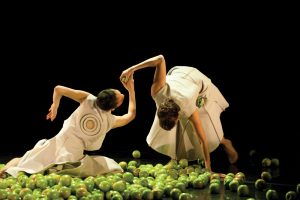The Road to Q Dance: Peter Quanz at home and abroad - Vancouver Ballet Society
- Home
- Features 2015 - 2019
- The Road to Q Dance: Peter Quanz at home and abroad

by Kaija Pepper
Q Dance made its debut at the Guggenheim Museum in New York in 2009, four months before it was actually founded in the mid-size prairie city of Winnipeg, Manitoba. Artistic director-to-be Peter Quanz was premiering his contemporary ballet, In Tandem, as part of a double bill shared with New York modern dance choreographer Larry Keigwin. Both works were set to Double Sextet by American minimalist composer Steve Reich, who was in attendance. In his review, the New York Times’ Alastair Macaulay praised the “sophisticated use” Quanz made of ballet vocabulary, and his attention to “the music’s detail as well as its layered complexity.”
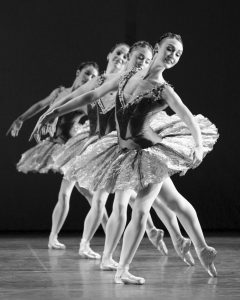
The review is illustrated with four of the six Royal Winnipeg Ballet dancers who performed In Tandem. Most of the cast knew Quanz from their RWB school days, when they were students together. They did the Guggenheim commission as a bit of a favour, and for the chance to perform in New York; the $10,000 budget was allocated for travel expenses and costumes — Anne Armit’s striking geometric patterned leotards — with nothing left over for salaries.
Armit was then director of wardrobe at the Royal Winnipeg Ballet, whose artistic director, André Lewis, was also on board for the project. Lewis generously facilitated the dancers’ involvement in rehearsals at the company’s studios when they weren’t busy working with Jorden Morris on what became the blockbuster ballet Moulin Rouge. When it was time to head out to New York, Morris helpfully agreed to the dancers’ weeklong absence.
The process of creating In Tandem with the Winnipeg dancers went so well that Quanz wanted to repeat it. “I’d been running around all over the place making work for different companies where I didn’t know the dancers beforehand,” Quanz says. “I realized that in Winnipeg, with my own company, I could have one project a year that would be like an anchor.”
The Royal Winnipeg Ballet’s support has been critical to Q Dance’s development. In 2013, when Q Dance was included as part of their season for the first time, Quanz had the assistance of the established company’s marketing professionals, contributing to the success of a sold-out four-night run at the intimate Gas Station Arts Centre. He also enjoys access to studio space in their spacious downtown home.
“Each company has its own culture,” Quanz says about the relationship between the two groups. “It’s not just getting one person on board, you have to convince everybody there’s a reason why it’s good to do the extra work. It takes a lot of discussion.”

Photo: Natasha Ulanova
Q Dance founding member Vanessa Lawson, a former principal dancer with the Royal Winnipeg Ballet, is now a ballet master with both companies. RWB first soloist Yosuke Mino, another founding member, continues to dance for both. “Peter was my classmate at the RWB School,” Mino recalls. “We’d learn steps on a Monday and be expected to memorize them for the rest of the week. None of us really did except Peter, so we’d always put him in the front. He’s got a brain!” Mino teases.
Quanz grew up in the small Ontario town of Baden, where he was raised as a Mennonite. He knew from the age of nine he wanted to be a choreographer, after his parents took him and his sister to see Brian Macdonald’s production of Guys and Dolls in Stratford, Ontario. “It was the way he did the set changes,” Quanz recalls. “The actors and dancers were choreographed in how they carried them off. A scene would kind of ebb away and another one replaced it; it was all beautifully interwoven.” When he told his grade four teacher about the show, she asked if he wanted to be up onstage. “I said, ‘No, I have ideas and I want to tell the dancers what to do.’ She said, ‘OK, it sounds like you’re a choreographer and should go to ballet school.’” He did, to the Academy of Dance in nearby Waterloo, Ontario, where he was taught by Carolyn Zettel-Augustyn.
His choreographic drive was strong early on, and while still in high school, the University of Waterloo allowed him to choreograph alongside students in its now defunct dance program. When he met Macdonald at the Banff Centre’s summer dance intensive, he received more creative opportunities.
Quanz left home at 17 to study at the RWB School, making several pieces for its Young Choreographers’ Evening. He also worked privately with Arnold Spohr, who had long retired as the company’s artistic director but was still a keen talent-spotter. Spohr, who died in 2010, had presented works by several men — Macdonald, Norbert Vesak, John Neumeier and Oscar Araiz — early in their careers; Quanz was his last discovery. “Mr. Spohr gave me grueling four-hour-long classes where he would teach me how to coach, how to break things down,” says Quanz.
After graduating in 1999, he danced briefly with Dutch National Ballet and Stuttgart Ballet, but visiting leading European choreographic centres and companies as an observer proved more compelling. He travelled by hiding in the bathroom on trains, he ate cheap soup in company canteens and he snuck in the back door of opera houses in order to see performances. “I needed an education,” Quanz says. “I needed to see what people were doing.”
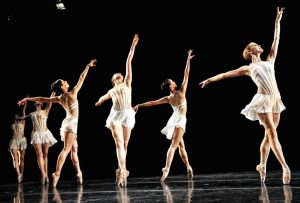
Quantz by Quanz
Photo: Vince Pahkala
He also needed to make work, which he did at Stuttgart Ballet through the Noverre-Society’s Young Choreographers’ evening, and, in 2002, at the New York Choreographic Institute. Allegro con Moderato, for the latter, led to John Meehan’s invitation to make a piece for American Ballet Theatre Studio Company.
SpringScape was created for 12 young Studio Company dancers during a residency at the luxurious White Oak Plantation in Florida. After-hour activities included horseback riding, archery and bowling. Quanz, who has a wry sense of humour, wrote about finding inspiration while bowling, posted at ballet.co.uk: “One of the girls always did a funny little jump before releasing the ball, while I moved into arabesque on plié to gently let go. I combined both techniques to create one of the steps in my ballet, which appears in the First and Third Movements.”
American Ballet Theatre’s Kevin McKenzie saw SpringScape and asked Quanz to create a piece, resulting in Kaleidoscope, to Saint-Saëns. After attending the 2005 premiere at New York’s City Center, Tobi Tobias wrote about it for Bloomberg News (republished in her blog Seeing Things),calling Kaleidoscope “an astonishingly confident and inventive neoclassical work by a little-known choreographer, 26-year-old Canadian Peter Quanz.”
Other major works that year included Quantz by Quanz, a neoclassical ballet for 14 dancers to a classical concerto for flute by Johan Joachim Quantz, created for the Banff Centre’s Clifford E. Lee Choreographic Award commission, and Charlies Kreuzfahrt (Charlie’s Cruise) for Germany’s Chemnitz Ballet. Chemnitz snapped him up after Quanz sent videotapes of his work all over Europe. Charlies Kreuzfahrt, his first full-length narrative ballet, was set to Cole Porter, and placed its title character, Charlie Chaplin, aboard a luxury yacht.
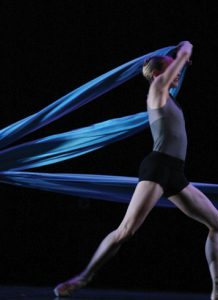
Noverre-Society’s Young Choreographers 2001
Photo: Courtesy of Peter Quanz
And so Quanz’s career has gone, one thing leading to another, in what has quickly become an impressive big-company résumé. In 2007, he was the first Canadian choreographer to create a work for Russia’s Mariinsky Ballet, Aria Suspended, set to Stravinsky’s Symphony in C. In 2008, he premiered Jupiter Symphony with Pennsylvania Ballet; in 2009, the year of In Tandem, Quanz’s In Colour premiered at the National Ballet of Canada. There were two major commissions in 2010: Le Papillon, about Romantic ballerina Marie Taglioni and her pupil Emma Livry, for the National Ballet of Cuba; and Luminous, to music by Marjan Mozetich, for Hong Kong Ballet. Also that year, his first work for the newly established Q Dance: Double Bounce, a playful, contemporary duet set to David Lang.
Quanz headed to Siberia the following year, where he made Souvenir de Bach and Dzambuling for Buryatian National Ballet. He also premiered the full-length narrative Rodin/Claudel for Les Grands Ballets Canadiens de Montréal. Quanz’s achievement in evoking sculptures by both the great Auguste Rodin and the great, though less known, Camille Claudel, was a highlight of the choreography.
“As a guest choreographer,” Quanz says about his travels, “you have to navigate the many needs of the institution while still exposing your own self.” There have, of course, been some instances where the challenges were onerous, where Quanz felt like a mere replaceable part. “Dance is a messy business,” he says. “Many people are involved, aesthetics collide, individuals confront Goliaths of institutions.” He admits, too, there have been times when prestige competed with artistic priorities.
Though Q Dance now takes up much of his creative energy, he has projects in process with Montréal Danse and China’s Wuxi Song and Dance Theatre. “They all tumble!” he says of the latter, anticipating getting to know the company of forty dancers. These global assignments are necessary for financial survival, but also, says Quanz, “I get incredible cultural immersions. I get to learn how other people do things, I get to work with fabulous dancers, to meet other choreographers.”
He’s interested in cultural history, too. “There are three great artists I really look up to: Picasso, Stravinsky, Balanchine. All these artists had a dialogue with the past while making something in the present. That’s what I want to do.”
Quanz praises Balanchine’s range: “Balanchine made Theme and Variations, a classical ballet with Tchaikovsky music, which premiered a year after Four Temperaments, a black-and-white ballet to a commissioned score, the most modern possible, by Hindemith. Then there’s Slaughter on Tenth Avenue [to music by Richard Rodgers, and originally part of a musical, On Your Toes].”
Today, at 35 years old, Quanz continues to hone and define his own aesthetic territory. That includes narrative ballets like Charlies Kreuzfahrt, Le Papillon, Rodin/Claudel and the period whodunit spoof, Murder Afoot, for Q Dance’s 2013 home season, which is filled with iconic ballet references. But even his more abstract works have a hint of story. “Rather than just movement for the sake of movement, Peter is really interested in exploring emotions, which adds depth,” André Lewis says. “In Luminous, for instance, which is plotless, there are connections between people, as well as between movements, and all those connections mean the difference between something having real quality and being just average.”
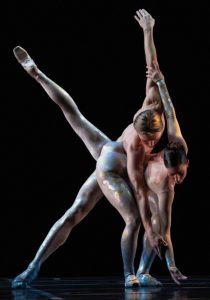
Photo: Bruce Monk
Luminous is one of three Quanz ballets Lewis has remounted on the Royal Winnipeg Ballet. In June, the RWB will present another Q Dance mixed bill, this time at the mid-size, 800-seat Manitoba Theatre Centre. For the evening, Quanz commissioned Gabrielle Lamb, the Savannah, Georgia-born recipient of the Banff Centre’s 2014 Clifford E. Lee Choreographic Award. Lamb danced a principal role when Les Grands Ballets Canadiens remounted Quanz’s Kaleidoscope,and, he explains, “We hit it off well. Now she’s living in New York and doing a lot of choreography.”
Quanz will remount his 2013 Q Dance work Untitled, which explores trust and betrayal in a close-knit community. It’s inspired by a story he heard while working in Chemnitz about an artist whose wife, unknown to him, was a member of the Stasi, the East German secret police, and provided reports on his activities. The piece is called Untitled because, he explains, there is no word to describe such an act of betrayal.
Alert to his responsibilities as the artistic director of Q Dance to provide a range of ballets to the loyal audience he hopes to build over the long term, he plans on making another very contrasting piece for the bill. “For the new work,” Quanz says thoughtfully, “I think I need to do something bright and fun.”
